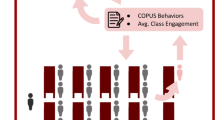Abstract
Recent investigations into the behavior states of students with profound and multiple disabilities have underlined the importance of better understanding the part that educational variables play in relation to levels of individual alertness and involvement. In the study reported here, 10 students in this population were observed for a full day each and detailed, noncontinuous information was collected on several contextual factors and student behavior states, using an interval recording technique. This paper examines transitional probabilities for observed student behavior states over time and also explores potential relationships between states, communicative conditions and activities taking place in educational settings. These sequential estimates provide evidence of state stability and positive relationships amongst student engagement and active communicative and social learning environments. Implications for practice and further research are discussed.
Similar content being viewed by others
REFERENCES
Arthur, M. (1998). Socio-Communicative Variables and Behaviour States in Students With the Most Severe and Multiple Disabilities: An Observational Study, Unpublished doctoral thesis, Macquarie University, Sydney, Australia.
Arthur, M. (2000). Behavior states and a half-full glass: A response to Mudford, Hogg and Roberts. Am. J. Ment. Retard. 105: 509–511.
Arthur, M. (2003). Socio-communicative variables and behavior states in students with profound and multiple disabilities: Descriptive data from school settings. Educ. Train. Dev. Dis. 38: 200–219.
Ault, M. M., Guy, B., Guess, D., Bashinski, S., and Roberts, S. (1995). Analyzing behavior state and learning environments: Application in instructional settings. Ment. Retard. 33: 304–316.
Bakeman, R., Adamson, L. B., and Strisik, P. (1995). Lags and logs: Statistical approaches to interaction (SPSS version). In Gottman, J. M. (ed)., The Analysis of Change, Erlbaum, Hillsdale, NJ, pp. 279–308.
Bakeman, R., and Gottman, J. M. (1997). Observing Interaction: An Introduction to Sequential Analysis, 2nd ed., Cambridge University Press, New York.
Grossman, H. J. (ed.) (1983). Classification in Mental Retardation, American Association on Mental Deficiency, Washington, DC.
Guess, D., and Carr, E. (1991). Emergence and maintenance of stereotypy and self-injury. Am. J. Ment Retard. 96: 299–326.
Guess, D., Mulligan Ault, M., Roberts, S., Struth, J., Siegel-Causey, E., Thompson, B., Bronicki, G. J. B., and Guy, B. (1988). Implications of biobehavioral states for the education and treatment of students with the most profoundly handicapping conditions. J. Assoc. Pers. Severe Handicaps 13: 163–174.
Guess, D., Roberts, S., Behrens, G. A., and Rues, J. (1998). Response to Mudford, Hogg, and Roberts on continuous recording of behavior state. Am. J. Ment. Retard. 103: 75–79.
Guess, D., Roberts, S., and Guy, B. (1996). Implications of Behavior State for the Assessment and Education of Students With Profound Disabilities, Unpublished manuscript, The University of Kansas.
Guess, D., Roberts, S., Siegel-Causey, E., Ault, M. M., Guy, B., Thompson, B., and Rues, J. (1993a). Analysis of behavior state conditions and associated environmental variables among students with profound handicaps. Am. J. Ment. Retard. 97: 634–653.
Guess, D., Roberts, S., Siegel-Causey, E., Mulligan-Ault, M., Guy, B., Thompson, B., Rues, J., and Siegel-Causey, D. (1991). Investigations Into the State Behaviors of Students with Severe and Profound Handicapping Conditions, Monograph of the Department of Special Education, University of Kansas, Lawrence.
Guess, D., Roberts, S., Siegel-Causey, E., and Rues, J. (1995). Replication and extended analysis of behavior state, environmental events, and related variables among individuals with profound disabilities. Am. J. Ment. Retard. 100: 36–50.
Guess, D., Rues, J., Roberts, S., and Siegel-Causey, E. (1993b). Extended analysis of behavior state, environmental events, and related variables among students with profound disabilities: A final report (Contract No. H133G00078). National Institute of Disability Rehabilitation and Research, Washington, DC.
Guess, D., and Siegel-Causey, D. (1995). Attractor dimensions of behavior state changes among individuals with profound disabilities. Am. J. Ment. Retard. 99: 642–663.
Guess, D., Siegel-Causey, E., Roberts, S., Guy, B., Mulligan Ault, M., and Rues, J. (1993c). Analysis of state organizational patterns among students with profound disabilities. J. Assoc. Pers. Severe Handicaps 18: 93–108.
Guess, D., Siegel-Causey, E., Roberts, S., Rues, J., Thompson, B., and Siegel-Causey, D. (1990). Assessment and analysis of behavior state and related variables among students with profoundly handicapping conditions. J. Assoc. Pers. Severe Handicaps 15: 211–230.
Haberman, S. J. (1973). The analysis of residuals in cross-classified tables. Biometrics 29: 205–220.
Hays, W. L. (1981). Statistics, 3rd edn., Holt, Rinehart and Winston, New York.
Huck, S. W., and Cormier, W. H. (1996). Reading Statistics and Research, 2nd edn., Harper Collins, New York.
Levin, J., and Fox, J. A. (1994). Elementary Statistics in Social Research, 6th edn., Harper Collins, New York.
Luckasson, R., Coulter, D. L., Polloway, E. A., Reiss, S., Schalock, R. L., Snell, M. E., Spitalnik, D. M., and Stark, J. A. (1992). Mental Retardation: Definition, Classification, and Systems of Supports, 9th edn., American Association on Mental Retardation, Washington, DC.
Mudford, O. C., Hogg, J., and Roberts, J. (1997). Interobserver agreement and disagreement in continuous recording exemplified by measurement of behavior state. Am. J. Ment. Retard. 102: 54–66.
New South Wales Department of School Education (1996). Interim Information for Support Services and Equity Personnel, New South Wales Department of School Education, Sydney.
Reese, R. M. (1997). Biobehavior analysis of self-injurious behavior in a person with profound handicaps. F. Autism Other Dev. Dis. 12: 87–94.
Richards, S. B., and Richards, R. Y. (1997). Implications for assessing biobehavioral states in individuals with profound disabilities. F. Autism Other Dev. Dis. 12: 79–86.
Richards, S. B., and Sternberg, L. (1992). A preliminary analysis of environmental variables affecting the observed biobehavioral states of individuals with profound handicaps. J. Int. Dis. Res. 36: 403–414.
Author information
Authors and Affiliations
Corresponding author
Rights and permissions
About this article
Cite this article
Arthur, M. Patterns Amongst Behavior States, Sociocommunicative, and Activity Variables in Educational Programs for Students with Profound and Multiple Disabilities. Journal of Developmental and Physical Disabilities 16, 125–149 (2004). https://doi.org/10.1023/B:JODD.0000026611.24306.92
Issue Date:
DOI: https://doi.org/10.1023/B:JODD.0000026611.24306.92




